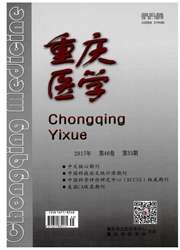

 中文摘要:
中文摘要:
目的探讨h Cu,Zn-SOD-PTD融合蛋白的表达及其穿膜功能。方法首先,人工设计合成蛋白转导域序列(protein transduction domain,PTD),以人胚肝组织的总RNA为模板,逆转录扩增得人铜锌超氧化物歧化酶全长c DNA序列。其次,将此序列及人工合成PTD序列定向插入p ET16b载体;测序鉴定后,将构建成功的重组载体导入E.coli BL21菌株,异丙基-β-d-硫代半乳糖苷(isopropyl-β-d-thiogalactoside,IPTG)诱导表达,经镍柱纯化,洗脱液经SDS-PAGE检测。最后,将纯化产物与食管癌细胞(EC9706)共孵育,用激光共聚焦和流式细胞仪的方法检测蛋白穿膜能力及活性。结果测序结果与人铜锌超氧化物歧化酶全长c DNA序列相符;SDS-PAGE结果出现18.6 kd和20 kd的目的条带;激光共聚焦和流式细胞仪的方法显示蛋白可穿膜且保持活性。结论本实验成功构建了PET16b/h Cu,Zn-SOD-PTD原核表达质粒,可在大肠杆菌中稳定表达融合蛋白,融合蛋白具有穿膜且保持活性。
 英文摘要:
英文摘要:
Objective To study the expression and trans-membrane activity of human Cu, Zn-SODPTD. Methods First, protein transduction domain(PTD) sequence was designed and synthesized. Human Cu, Zn-SOD was amplified by reverse transcription PCR using the complete RNA of human embryonic liver as a template. Second, h Cu, Zn- SOD gene and PTD sequence were inserted into p ET16 b plasmid. Then the recombinant plasmids were transformed into E. coli BL21 after sequencing identification. After being induced by isopropyl-β-d-thiogalactoside(IPTG), the fusion proteins were purified by nitrilotriacetic acid sepharose and the results were determined by SDS-PAGE. Third, the fusion proteins were co-cultured with the EC9706 cells and the trans- membrane activity was tested by laser scanning confocal microscopy and flow cytometer.Results The sequencing results were consistent with the full length c DNA sequence of h Cu, Zn-SOD, and the results of SDS-PAGE showed 18.6 kd and 20 kd bands. The results oflaser scanning confocal microscopy and flow cytometer showed that the fusion proteins could be transduced into EC9706 cells and were enzymatically active. Conclusion Recombinant PET16 b plasmids containing h Cu, Zn-SOD-PTD gene were constructed successfully and fusion h Cu, Zn-SOD-PTD proteins could be transduced into the cell membrane efficiently without the loss of enzymatic activity.
 同期刊论文项目
同期刊论文项目
 同项目期刊论文
同项目期刊论文
 期刊信息
期刊信息
